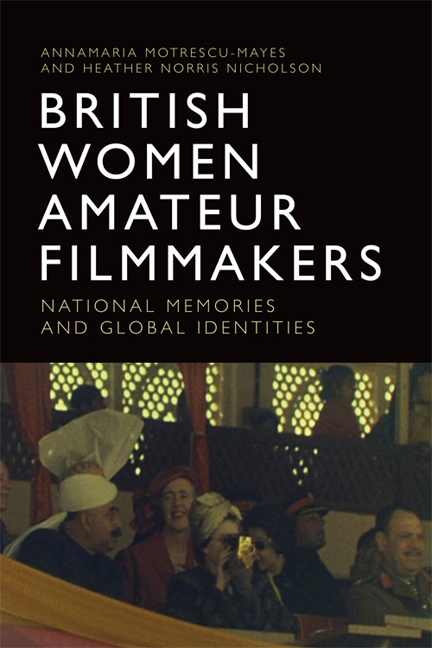Book contents
- Frontmatter
- Contents
- List of Figures
- List of Sources and Abbreviations
- Acknowledgements
- Foreword
- 1 Amateur Women Filmmakers as Producers of Cultural Meaning
- 2 Webs of Production and Practice
- 3 Resisting Colonial Gendering while Domesticating the Empire
- 4 Cameras Not Handbags: The Essential Accessory
- 5 Through Women's Lens: Imperial and Postcolonial Class and Gender Hierarchies
- 6 Teacher Filmmakers
- 7 British Women's Media Narratives of Gender and Collective Memory
- 8 Reimagining Boundaries: Amateur Animations
- Afterword
- Selected Bibliography
- Index
1 - Amateur Women Filmmakers as Producers of Cultural Meaning
Published online by Cambridge University Press: 12 November 2019
- Frontmatter
- Contents
- List of Figures
- List of Sources and Abbreviations
- Acknowledgements
- Foreword
- 1 Amateur Women Filmmakers as Producers of Cultural Meaning
- 2 Webs of Production and Practice
- 3 Resisting Colonial Gendering while Domesticating the Empire
- 4 Cameras Not Handbags: The Essential Accessory
- 5 Through Women's Lens: Imperial and Postcolonial Class and Gender Hierarchies
- 6 Teacher Filmmakers
- 7 British Women's Media Narratives of Gender and Collective Memory
- 8 Reimagining Boundaries: Amateur Animations
- Afterword
- Selected Bibliography
- Index
Summary
What beats me Helen is how you became such an expert film producer? Shall I let you into a secret? With Ciné-Kodak everybody becomes an expert first go off. It's even easier than snap-shotting because there's no worrying about keeping your subjects in order. (Anon. 1929a: 4)
An image of a family watching a home movie about a child and a dog playing accompanies these lines in Kodak's promotion of lightweight cine equipment to British audiences in early 1929. With her bobbed hair and a low-necked printed dress, the eponymous Helen epitomises the young, modern female cine user. She embodies the ambivalence of womanhood in a new age of consumerism and represents the ambiguities of interwar middle class femininity. Kodak's advertising strategy promises the transformative power of consumption; evolving visual technologies make filming possible – even for women. Helen side-steps male incredulity and the challenges of childcare without nanny or governess support to invite Punch's readers into a domestic world where movie-making routinely helps ‘to keep the family together’ (Anon. 1929b) and safeguard ‘youth, colour, frolic, movement – stolen intact from time’ (Anon. 1931a: 3).
Helen, like other fictive women amateur filmmakers, recurs in Kodak's outreach to an early female amateur market: ‘Simply to hold this beautiful instrument – elegant as a jewel case, compact as a novel, is to begin to feel the thrill of making movie pictures’ (ibid.). Language and imagery construct prospective users and target purchasers, emphasising the equipment's apparent feminised suitability and appeal via jargon-free terms (‘the hidden motor [that] begins to purr’) and ‘wonderfully easy’ operation (of ‘the little trigger’) that is stress-free and ‘thrilling’ (ibid.). Fortunately for Kodak's sales, camera use expanded beyond the drawing-room world evoked by these colour advertisements, and cine film's visual novelty attracted broader female interest. This book examines how that outreach occurred; where and how women made and showed their films; and what those experiences reveal about the women holding the cameras and the profoundly changing twentieth-century world they captured on screen. As taboos and patriarchal structures receded, societal and geo-political changes enabled and necessitated women to live, work and behave differently from their predecessors. At home and abroad, their self-expression and social purpose found fresh outlets via amateur filmmaking, the newest branch of photography.
- Type
- Chapter
- Information
- British Women Amateur FilmmakersNational Memories and Global Identities, pp. 1 - 29Publisher: Edinburgh University PressPrint publication year: 2018



